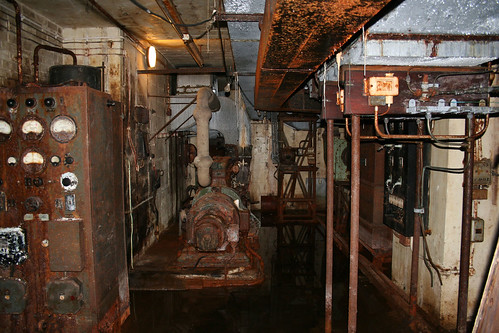Deep under a housing estate in North London lies one of World War Two’s greatest secrets, the reserve Cabinet War Rooms that lay hidden and waiting just in case the (now) more famous Westminster bunkers were attacked.
Used just once for a full cabinet meeting, the reserve bunker was mothballed even before the war had ended as a much larger replacement was built underneath what is today the Home Office buildings in Victoria.
Secret during the war, their existence barely known about even amongst military historians, and only located for certain once again in the 1980s, this underground bunker is open on just 2 days per year.
And the dates have been confirmed for Thur 9th May 2013 and a Saturday in Sept for Open House Weekend.
You can only reserve slots for the May visit at the moment.
The May tour is probably better anyway, as they tend to be a bit quieter than the September open day – so if you want to follow in the footsteps of Churchill, and see the dank unrestored interior of a WW2 bunker built deep underneath the Neasden hills – send an email to Katy.Bajina@networkhg.org.uk with your details and suggest what time of day you would like so she can see if spaces are available.
Tours are free – but a big shouty man may try to sell you a book about bunkers in the UK, so bring a fiver with you.
Tours (lasting just under an hour) run on the hour from 9am – 4pm. Actually, you can turn up without booking but if the tour is fully booked you will have to wait till the next tour. Best to book in advance!
You can read more about the bunker on my blog post from last year.
More by coincidence than design, the two Cabinet War Rooms — in Neasden and Westminster — are both close to the Jubilee Line, so why not make a day of it and visit both – then compare them?









What an amazing opportunity – thank you Ian for letting us all know. After reading your blog I looked up Operation Paddock and found a fascinating pdf by Katy. Well worth a read http://www.networkstadium.org.uk/files/ART118_paddock.pdf
Working day — and likely to be a busy one. Damn.
This is built on the site of the Dollis Hill research centre used by the GPO (ancestor of BT) until it moved its R&D to Martlesham, Suffolk, in the mid-1970s. Look at the location of the bunker, and you’ll see Flowers Close. This street is named after Tommy Flowers, the Poplar-born engineer who worked for the GPO at Dollis Hill during the war and designed Colossus, the world’s first programmable computer, which was used at Bletchley Park to crack German WW2 codes, even more complex than the famous Enigma codes.
After the war he stayed at GPO Dollis Hill and pioneered electronic telephone exchanges.